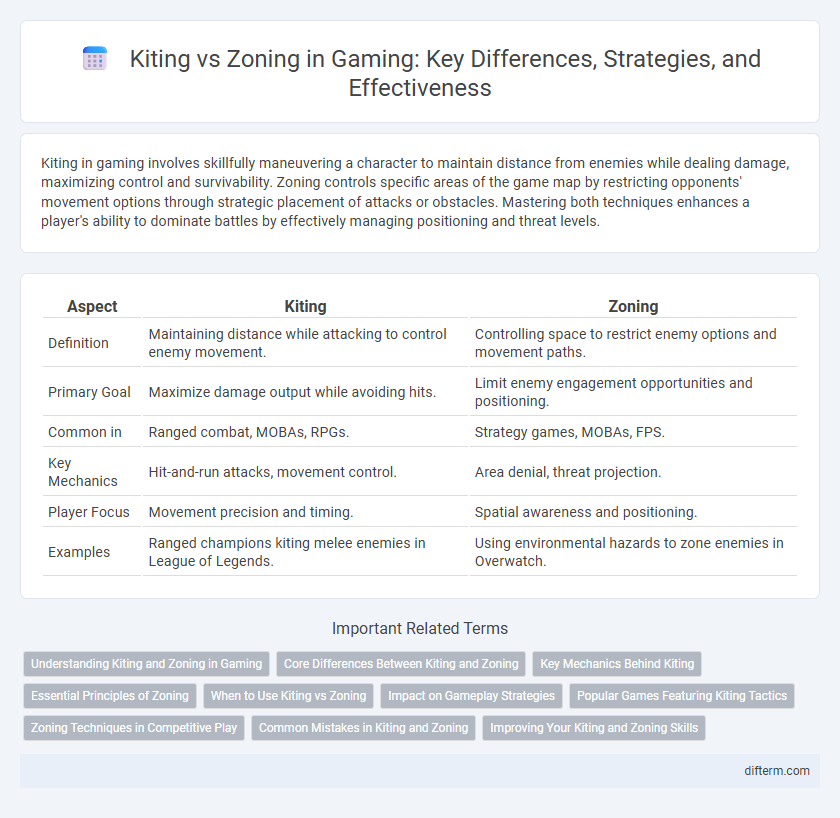Kiting in gaming involves skillfully maneuvering a character to maintain distance from enemies while dealing damage, maximizing control and survivability. Zoning controls specific areas of the game map by restricting opponents' movement options through strategic placement of attacks or obstacles. Mastering both techniques enhances a player's ability to dominate battles by effectively managing positioning and threat levels.
Table of Comparison
| Aspect | Kiting | Zoning |
|---|---|---|
| Definition | Maintaining distance while attacking to control enemy movement. | Controlling space to restrict enemy options and movement paths. |
| Primary Goal | Maximize damage output while avoiding hits. | Limit enemy engagement opportunities and positioning. |
| Common in | Ranged combat, MOBAs, RPGs. | Strategy games, MOBAs, FPS. |
| Key Mechanics | Hit-and-run attacks, movement control. | Area denial, threat projection. |
| Player Focus | Movement precision and timing. | Spatial awareness and positioning. |
| Examples | Ranged champions kiting melee enemies in League of Legends. | Using environmental hazards to zone enemies in Overwatch. |
Understanding Kiting and Zoning in Gaming
Kiting in gaming involves maintaining distance from opponents while dealing damage, effectively controlling the pace of combat by moving strategically to avoid retaliation. Zoning focuses on controlling specific areas of the map to restrict enemy movement and influence their positioning, often utilizing abilities or terrain to create threat zones. Mastering both kiting and zoning enhances tactical gameplay, allowing players to manipulate engagements and gain strategic advantages in competitive environments.
Core Differences Between Kiting and Zoning
Kiting involves continuously moving a character to maintain distance from enemies while dealing damage, emphasizing precise positioning and timing to avoid attacks. Zoning focuses on controlling specific areas of the map by using abilities or positioning to restrict enemy movement and influence engagement choices. The core difference lies in kiting's dynamic movement to evade and attack, whereas zoning prioritizes area control and spatial dominance.
Key Mechanics Behind Kiting
Kiting in gaming involves maintaining distance from enemies while continuously dealing damage, relying on precise movement and attack timing to control engagements. The key mechanics behind kiting include strategic positioning, optimal attack intervals, and effective use of crowd control abilities to prevent pursuit. Mastering kiting enhances survivability and damage output by exploiting enemy weaknesses and minimizing direct confrontation.
Essential Principles of Zoning
Zoning in gaming revolves around controlling space to restrict opponents' movement and create strategic advantages by positioning attacks and defenses precisely. Core principles include maintaining optimal distance, predicting enemy approaches, and utilizing area-denial tactics to limit adversaries' options. Mastering zoning enhances map control, forces opponents into unfavorable engagements, and sets the stage for effective follow-up attacks.
When to Use Kiting vs Zoning
Kiting is most effective when facing melee opponents or slower enemies, allowing players to maintain distance while continuously dealing damage. Zoning excels in controlling enemy movement and restricting access to strategic areas, ideal for team fights and objective defense. Choosing between kiting and zoning depends on the player's role, enemy composition, and map objectives to maximize control and damage output.
Impact on Gameplay Strategies
Kiting enhances gameplay strategies by allowing players to control enemy movement through hit-and-run tactics, effectively maximizing damage while minimizing risk. Zoning influences map control and area denial, forcing opponents to reposition and adapt their strategies. Both tactics shape engagement timing and spatial awareness, crucial for strategic advantages in competitive gaming.
Popular Games Featuring Kiting Tactics
Popular games featuring kiting tactics include League of Legends, where players control champions to attack while maintaining distance from opponents, and World of Warcraft, where ranged classes use kiting to avoid melee damage. In Dota 2, heroes utilize kiting to maximize damage output while minimizing risk. These games demand precise movement and positioning skills, highlighting the strategic importance of kiting in competitive play.
Zoning Techniques in Competitive Play
Zoning techniques in competitive gaming involve controlling space to restrict enemy movement and force unfavorable positioning, enhancing map control and resource management. Effective zoning relies on predicting opponent behavior and utilizing area denial tools such as projectiles, traps, and skill shots to create pressure points. Mastery of zoning maximizes team advantage by limiting enemy engagements and dictating the pace of the match.
Common Mistakes in Kiting and Zoning
Common mistakes in kiting include poor positioning that allows enemies to close the distance too quickly and inconsistent attack timing, reducing damage efficiency. In zoning, a frequent error is overextending to control space, which exposes the player to counterattacks and loss of map control. Both techniques demand precise spatial awareness and timing to maintain effective crowd control without compromising safety.
Improving Your Kiting and Zoning Skills
Improving your kiting and zoning skills involves mastering movement control and positioning to outmaneuver opponents while maintaining optimal attack range. Practicing precise timing and spatial awareness enhances your ability to kite effectively, keeping enemies at bay without taking damage, while refining zoning tactics creates pressure and controls enemy movement. Incorporating these strategies into gameplay increases survivability and strategic dominance in competitive gaming scenarios.
Kiting vs Zoning Infographic

 difterm.com
difterm.com